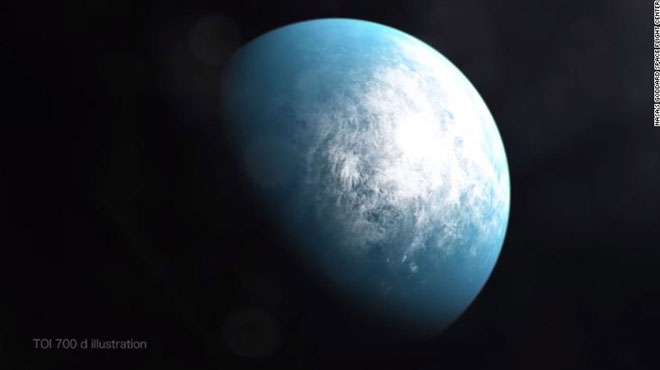Detect planets that may contain life 100 light-years from Earth
TESS, NASA's 'planetary hunt' program, has found a first habitable exoplanet about the size of Earth, orbiting a star about 100 light-years from us.
The discovery was announced during the 235th meeting of the American Astronomical Society in Honolulu on 6 January.
The planet is part of a multi-planetary system orbiting TOI 700, a small, cold dwarf star in the constellation of Dorado. This star is only 40% the mass and size of our Sun, and has a surface temperature of only half that.

Artwork of the TOI planet 700 d.(Photo: NASA).
The planet is known as TOI 700d , one of the three planets orbiting the dwarf star. This is the right distance to help support liquid water on the star's habitable zone.
Astronomers say their discovery uses the infrared capabilities of NASA's Spitzer Space Telescope. They also modeled the planet's environment to further investigate its viability.
This finding is interesting to astronomers because it is one of the few planets capable of life outside the Solar System of about the same size as the Earth.
TOI 700d is the outermost of the three planets above, completing an orbit around the host star in a time equivalent to 37 days on Earth. From the smaller star, the planet receives about 86% of the energy the Sun provides to the Earth. Half of the planet is thought to be daytime at all times.
The other two planets in this system, TOI 700 b and c, are different . The innermost planet, TOI 700b, is about the size of Earth and is a rocky planet, completed orbiting the host star in about 10 days. The second planet, TOI 700c, is considered a gas planet, about the size of Earth and Neptune, completing its orbit in 16 days.
"TESS is specifically designed and launched to find Earth-sized planets orbiting nearby stars," said Paul Hertz, director of the astrophysics division at NASA Headquarters in Washington. "The planets around nearby stars are the easiest to follow with larger telescopes in space and on Earth. The TOI 700 d discovery is an important scientific discovery for TESS. the size and state of the planet's habitable zone is another Spitzer victory when the telescope ended its scientific activity in January of this year. '
In the future, missions such as NASA's James Webb Space Telescope, launched in 2021, can determine whether planets have atmospheres and atmospheric components.
- The "super Earth" planet may contain life
- Discover planets with life outside the Solar System
- The super-Earth planet may contain life
- It is possible to confirm life on three Earth-like planets over the next decade
- New technology helps detect planets outside the solar system
- Discover more than 700 planets outside the solar system
- Discover more planets 'brothers of the Earth' and can survive life
- Discovering 'Earth Stone' has 3 suns at the same time
- Reading light helps locate Earth-like planets
- Discover 3 extremely rare extrasolar planets only 73 light-years from Earth
- Kepler discovered 20 Earth-like planets that could contain life
- Earth-like planets may contain life
- Water turns out to be full of our galaxy, and so is life
- The most exotic new planets 2012
 'Fine laughs' - Scary and painful torture in ancient times
'Fine laughs' - Scary and painful torture in ancient times The sequence of numbers 142857 of the Egyptian pyramids is known as the strangest number in the world - Why?
The sequence of numbers 142857 of the Egyptian pyramids is known as the strangest number in the world - Why? History of the iron
History of the iron What is alum?
What is alum? NASA's 'Ninth Planet' Shows Signs of Being Friendly to Life
NASA's 'Ninth Planet' Shows Signs of Being Friendly to Life  Which planet is the oldest and youngest in the Solar System?
Which planet is the oldest and youngest in the Solar System?  Breakthrough discovery of planet with more water than Earth
Breakthrough discovery of planet with more water than Earth  How would humans die when visiting other planets?
How would humans die when visiting other planets?  Habitable planet appeared next to Earth, but met with disaster
Habitable planet appeared next to Earth, but met with disaster  Chinese spacecraft discovers mysterious cubes on other planets
Chinese spacecraft discovers mysterious cubes on other planets 